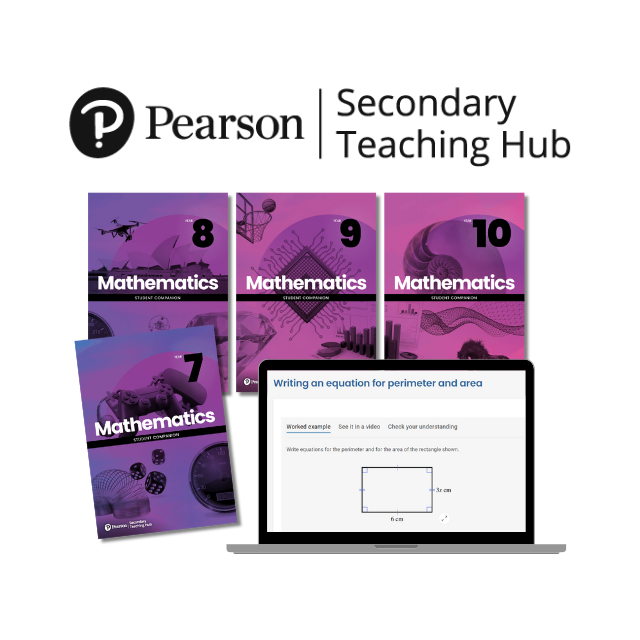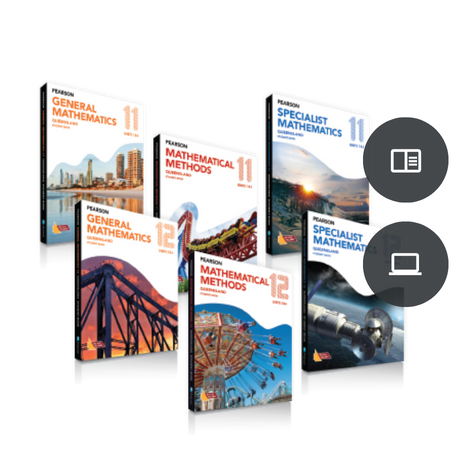Overview
Queensland Senior Mathematics was developed specifically for the 2019 Queensland senior secondary mathematics syllabus.
-
Year Levels 11–12
-
Curriculum QLD
-
Subject Mathematics
-
Resource Formats Print, Digital
-
Last Updated Nov 2019
What it is
Created by a team of experienced Queensland teachers, the series offers complete curriculum coverage and rich content to support student growth and assessment. Resources include:
- General Mathematics, Mathematical Methods and Specialist Mathematics student books for year 11 and 12
- digital eBooks featuring student book content, activities with worked examples and plus a teacher-only section with solutions, teaching programs and more
- comprehensive exam preparation workbooks supporting revision with preparatory steps, common errors and worked solutions.
What it includes
Components
Student books
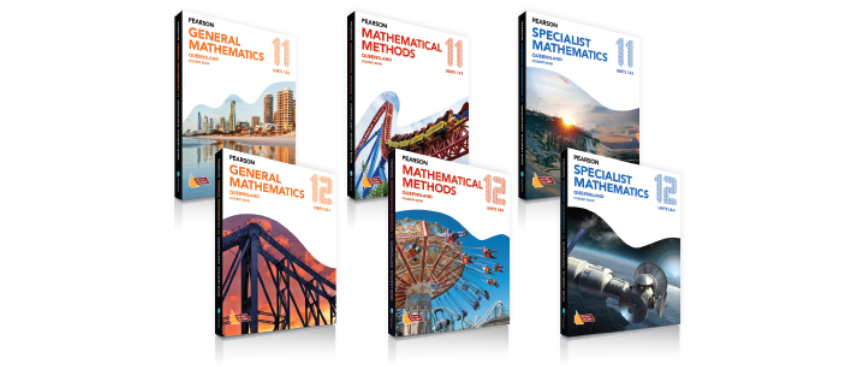
Created for the new senior maths QCAA syllabus to save you time and help you teach with confidence, the student books feature:
- questions and worked examples graded according to QCE levels of difficulty: simple familiar, complex familiar, and complex unfamiliar
- sample exams, question banks, technology activities, and fully worked solutions
- instructions for smart use of technology
- a focus on common errors for increased awareness.
Components
eBooks
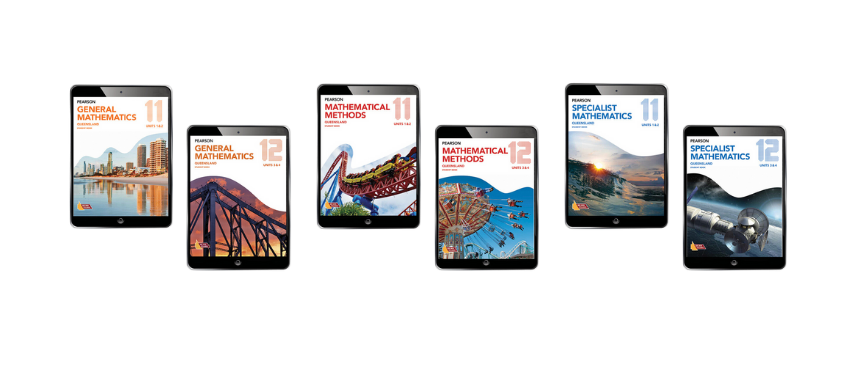
Supporting teaching and learning from the classroom and home, the eBooks help engage learners as they consolidate understanding of concepts and ideas. They feature:
- online and offline access to student book content
- digital activities
- interactive videos
- investigations
- exam preparation material.
Components
Exam preparation workbooks
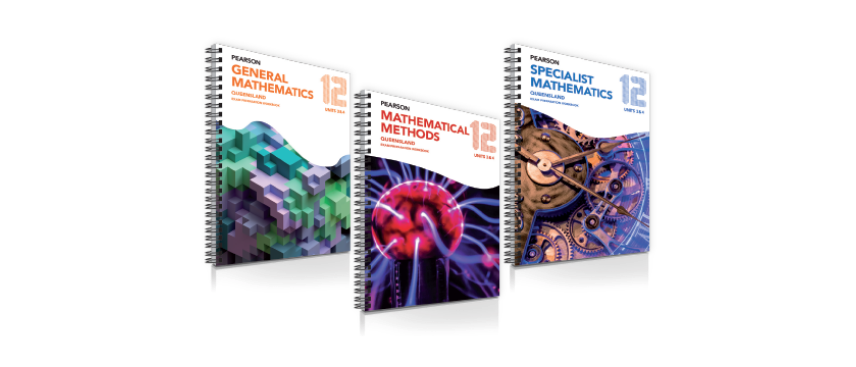
Developed to support senior maths students in their preparation for the QCAA external exams, the workbooks feature:
- past external exam questions from other states, selected based on their alignment with the QCAA syllabus, and then categorised using the QCAA three levels of question difficulty: simple familiar, complex familiar and complex unfamiliar.
- a 5-Step exam preparation approach to support students in their revision and help them identify gaps and areas of strength
- extra support for year 12 students to build confidence for exams
- worked solutions and notes on common errors.
Components
Teacher support
Focused on saving teachers time and teach with confidence, this series features:
- curriculum-aligned teaching programs
- curriculum grids
- question banks
- Interactives
- technology integration support
- formative and summative assessment tasks
- problem solving and modeling tasks to support internal assessment.
Video overviews
External exams covered
See how the series guides students over both senior years to prepare them for the new external exams.
Video overviews
Support for internal assessments
See how the series supports students and teachers with additional support materials including problem solving and modeling tasks for both year 11 and 12.
Video overviews
Key differences - the current and incoming syllabus
Learn more about the work solutions and the content structure based on the syllabus mapping.
Video overviews
Strengthening technology-free skills
We listened to what teachers have been telling us they need. Learn more about the exercises we’ve designed to help students solve questions without the use of a calculator.
Video overviews
Strengthening technology skills
Learn how the new resources accommodate the technology active teaching components, and how questions are presented to help students identify when a calculator is required to solve.
Table of contents
General Mathematics Year 11 for Queensland
1 Consumer arithmetic
Recall
- 1.1 Percentages, decimals and rates
- 1.2 Making money
- 1.3 Taxation and other government charges
- 1.4 Investing money
- 1.5 Shares
- 1.6 Profit, loss and inflation
- 1.7 Making the most of your money
- 1.8 Working with finance
- Chapter summary
- Chapter review
2 Measurement
Recall
- 2.1 Pythagoras’ theorem
- 2.2 Perimeter and area
- 2.3 Volume of prisms and cylinders
- 2.4 Volume of tapered solids and spheres
- 2.5 Surface area of prisms and cylinders
- 2.6 Surface area of tapered solids and spheres
- Chapter summary
- Chapter review
3 Similar figures
Recall
- 3.1 Similar shapes and length
- 3.2 Scale drawing
- 3.3 Similar shapes and area
- 3.4 Similar solids and volume
- Chapter summary
- Chapter review
4 Linear equations and their graphs
Recall
- 4.1 Linear equations
- 4.2 Linear graphs
- 4.3 Sketching linear graphs
- 4.4 Simultaneous linear equations
- 4.5 Piece-wise linear graphs and step graphs
- Chapter summary
- Chapter review
5 Applications of trigonometry
Recall
- 5.1 Sine, cosine and tangent
- 5.2 Angles of elevation and depression
- 5.3 Directions and compass points
- 5.4 The sine rule
- 5.5 The cosine rule
- 5.6 Alternative formulas for triangle area
- Chapter summary
- Chapter review
6 Algebra and matrices
Recall
- 6.1 Linear and non-linear expressions
- 6.2 Matrix properties
- 6.3 Matrix addition, subtraction and scalar multiplication
- 6.4 Matrix multiplication
- 6.5 Networks and Power Matrices
- Chapter summary
- Chapter review
7 Univariate data analysis
Recall
- 7.1 Categorising and organising data
- 7.2 Categorical data
- 7.3 Numerical data
- 7.4 Median, range and interquartile range
- 7.5 Cumulative frequency
- 7.6 Mean and standard deviation
- 7.7 Comparing data
- Chapter summary
- Chapter review
Table of contents
General Mathematics Year 12 for Queensland
1 Bivariate data analysis
Recall
- 1.1 Association between categorical variables
- 1.2 Scatterplots and association
- 1.3 Modelling and the line of best fit
- 1.4 Residual analysis
- 1.5 The statistical investigation process
- Chapter summary
- Chapter review
2 Time series analysis
Recall
- 2.1 Time series
- 2.2 Seasonal variation
- 2.3 Smoothing
- 2.4 The statistical investigation process
- Chapter summary
- Chapter review
3 Growth and decay in sequences
Recall
- 3.1 Arithmetic sequences
- 3.2 Applications of arithmetic sequences
- 3.3 Geometric sequences
- 3.4 Applications of geometric sequences
- Chapter summary
- Chapter review
4 Earth geometry and time zones
Recall
- 4.1 Latitude and Longitude
- 4.2 Angular distances
- 4.3 Time Zones
- 4.4 Time and Travel
- Chapter summary
- Chapter review
5 Compound interest loans and investments
Recall
- 5.1 Financial sequences
- 5.2 Compound interest and recursion
- 5.3 The compound interest formula
- 5.4 Compound interest parameters
- 5.5 Effective annual rate of interest
- 5.6 Depreciation and appreciation
- Chapter summary
- Chapter review
6 Reducing balance loans, annuities and perpetuities
Recall
- 6.1 Repaying a loan
- 6.2 Reducing balance loans
- 6.3 Changing parameters
- 6.4 Annuities and perpetuities
- 6.5 Annuity investments
- Chapter summary
- Chapter review
7 Graphs and networks
Recall
- 7.1 Describing graphs
- 7.2 Practical networks
- 7.3 Adjacency matrices
- 7.4 Walks, trails, paths and cycles
- 7.5 Weighted networks
- Chapter summary
- Chapter review
8 Networks and decision mathematics
Recall
- 8.1 Minimum spanning trees
- 8.2 Network flow
- 8.3 Allocation problems
- 8.4 Project networks
- Chapter summary
- Chapter review
Table of contents
Mathematical Methods Year 11 for Queensland
1 Linear relations
Recall
- 1.1 Linear relations and functions
- 1.2 Solving simultaneous linear equations
- 1.3 Piece-wise functions
- 1.4 Arithmetic sequences and series
- 1.5 Linear growth and decay
- Chapter summary
- Chapter review
2 Quadratic functions
Recall
- 2.1 Introduction to quadratic functions
- 2.2 Transformations of quadratic functions
- 2.3 Solving quadratic equations
- 2.4 Determining the rule of a quadratic function
- Chapter summary
- Chapter review
3 Polynomial functions
Recall
- 3.1 Polynomials
- 3.2 Expanding cubic polynomials
- 3.3 Factorising cubic polynomials
- 3.4 Graphs of power functions
- 3.5 Graphs of cubic functions
- 3.6 Solving polynomial equations
- Chapter summary
- Chapter review
4 Advanced functions and relations
Recall
- 4.1 Inverse proportion and graphs of rectangular hyperbolas
- 4.2 The graph of x = y2
- 4.3 Circles
- Chapter summary
- Chapter review
5 Probability
Recall
- 5.1 Probability review
- 5.2 Probability and set notation
- 5.3 Conditional probability
- 5.4 Independent events
- 5.5 Counting techniques
- 5.6 Combinations
- Chapter summary
- Chapter review
6 Index Laws
Recall
- 6.1 Review of index laws
- 6.2 Scientific notation
- 6.3 Geometric sequences and series
- 6.4 Financial mathematics
- Chapter summary
- Chapter review
7 Exponential and logarithmic functions
Recall
- 7.1 Equations with exponentials
- 7.2 Graphs of exponentials functions
- 7.3 Indices and logarithms
- 7.4 Modelling with exponentials
- Chapter summary
- Chapter review
8 Trigonometric functions
Recall
- 8.1 Circular measure and radian measure
- 8.2 The unit circle
- 8.3 Dilations of trigonometric graphs
- 8.4 Translation of trigonometric graphs
- 8.5 Solving trigonometric equations
- 8.6 Applications of trigonometric functions
- Chapter summary
- Chapter review
9 Rates of change
Recall
- 9.1 Average and instantaneous rates of change
- 9.2 Functions and rates of change
- 9.3 Derivatives from first principles
- 9.4 Differentiation using the power rule
- Chapter summary
- Chapter review
10 Differential calculus
Recall
- 10.1 Gradients of functions and equations of tangents
- 10.2 Calculus and rates of change
- 10.3 Curve sketching
- 10.4 Maximum and minimum problems
- 10.5 Calculus and linear motion
- 10.6 Composite functions and their derivatives
- 10.7 Derivatives of products and quotients
- Chapter summary
- Chapter review
11 Discrete random variables
Recall
- 11.1 Random variables and probability
- 11.2 Statistics of discrete probability distributions
- 11.3 Uniform distributions
- 11.4 Probability distributions in practical applications
- Chapter summary
- Chapter review
Table of contents
Mathematical Methods Year 12 for Queensland
1 Derivatives of exponential functions
Recall
- 1.1 Euler’s number and index laws
- 1.2 Graphing exponential functions
- 1.3 Differentiating exponential functions
- 1.4 Applications of exponential functions
- 1.5 Further differentiation
- Chapter summary
- Chapter review
2 Trigonometric functions and derivatives
Recall
- 2.1 Radians and the unit circle
- 2.2 Solving trigonometric equations
- 2.3 Graphs of trigonometric functions
- 2.4 Derivatives of trigonometric functions
- 2.5 Applications of trigonometric functions
- Chapter summary
- Chapter review
3 Logarithmic functions and their derivatives
Recall
- 3.1 Logarithmic functions and their properties
- 3.2 Logarithmic equations
- 3.3 Logarithmic bases and exponential equations
- 3.4 Graphs of logarithmic functions
- 3.5 Logarithmic scales
- 3.6 The derivative of the natural logarithm
- 3.7 Applications of logarithms
- Chapter summary
- Chapter review
4 Anti-differentiation
Recall
- 4.1 Introduction to anti-differentiation
- 4.2 Anti-differentiation of power functions
- 4.3 Anti-differentiation of binomial power functions
- 4.4 Anti-differentiation of exponential functions
- 4.5 Anti-differentiation of sine and cosine functions
- 4.6 Anti-derivatives of reciprocal functions
- 4.7 Further anti-differentiation
- Chapter summary
- Chapter review
5 Definite integrals
Recall
- 5.1 Estimating area beneath curves
- 5.2 Finding definite integrals
- 5.3 Calculating area beneath curves
- 5.4 Finding area between curves
- 5.5 Kinematics applications of integration
- Chapter summary
- Chapter review
6 Further applications of differentiation
Recall
- 6.1 The derivative and curve sketching
- 6.2 Motion and derivatives
- 6.3 The second derivative and curve sketching
- 6.4 Maximum and minimum problems
- Chapter summary
- Chapter review
7 Sine and Cosine rules
Recall
- 7.1 Trigonometry review
- 7.2 The sine rule and the cosine rule
- 7.3 Areas of triangles
- 7.4 Bearings
- Chapter summary
- Chapter review
8 Binomial distributions
Recall
- 8.1 Discrete probability distributions review
- 8.2 Bernoulli trials and binomial distributions
- 8.3 Statistics of binomial probability distributions
- Chapter summary
- Chapter review
9 Continuous random variables and the normal distribution
Recall
- 9.1 Continuous random variables
- 9.2 The normal distribution
- 9.3 Standard normal distributions
- 9.4 Inverse of standard normal
- Chapter summary
- Chapter review
10 Interval estimates for proportions
Recall
- 10.1 Random sampling
- 10.2 The central limit theorem
- 10.3 Proportions
- 10.4 Estimating with confidence
- Chapter summary
- Chapter review
Table of contents
Specialist Mathematics Year 11 for Queensland
1 Combinatorics
Recall
- 1.1 Counting techniques
- 1.2 The multiplication and addition principles
- 1.3 Permutations
- 1.4 Combinations
- 1.5 Applications to probability
- 1.6 Pascal's triangle
- 1.7 The Pigeon-hole principle
- Chapter summary
- Chapter review
2 Vectors in the plane
Recall
- 2.1 Introduction to vectors
- 2.2 Vectors in two dimensions
- 2.3 Vectors in component form
- 2.4 Scalar product of vectors
- 2.5 Projections of vectors
- 2.6 Vectors in geometric proofs
- 2.7 Displacement and velocity problems
- 2.8 Problems involving forces
- Chapter summary
- Chapter review
3 Introduction to proof
Recall
- 3.1 Rational and irrational numbers
- 3.2 The language and logic of proof
- 3.3 Methods of proof
- Chapter summary
- Chapter review
4 Geometric properties and proof
Recall
- 4.1 Review of congruence and similarity
- 4.2 Geometric proof
- 4.3 Circle theorems, part 1
- 4.4 Circle theorems, part 2
- Chapter summary
- Chapter review
5 Real and complex numbers
Recall
- 5.1 Complex numbers
- 5.2 The complex plane
- 5.3 Radian measure
- 5.4 Complex arithmetic using polar form
- 5.5 Complex solutions of real quadratic functions
- Chapter summary
- Chapter review
6 Graphing functions
Recall
- 6.1 Absolute value functions
- 6.2 Reciprocal functions
- 6.3 Rational functions
- Chapter summary
- Chapter review
7 Trigonometry
Recall
- 7.1 Solving trigonometric equations
- 7.2 Graphing and modelling with trigonometric functions
- 7.3 The reciprocal trigonometric functions
- 7.4 The Pythagorean trigonometric identities
- 7.5 Compound and double-angle formulas
- 7.6 Transformations of trigonometric
- Chapter summary
- Chapter review
8 Introduction to matrices
Recall
- 8.1 Matrix properties and arithmetic
- 8.2 Matrix multiplication
- 8.3 Inverse matrices
- 8.4 Solving simultaneous linear equations with matrices
- 8.5 Translations in the plane
- 8.6 Linear transformations in the plane
- 8.7 Reflections, rotations and dilations
- 8.8 Applying transformations in the plane
- 8.9 Determining the transformation matrix
- 8.10 Combining transformations
- 8.11 Establishing geometric results by using matrix multiplication
- Chapter summary
- Chapter review
Table of contents
Specialist Mathematics Year 12 for Queensland
1 Mathematical Induction
Recall
- 1.1 Proof by induction
- 1.2 Proving results for sums
- 1.3 Proving divisibility
- Chapter summary
- Chapter review
2 Vectors and Matrices
Recall
- 2.1 Vectors review
- 2.2 Vectors in three dimensions
- 2.3 Scalar product of vectors and projections of vectors
- 2.4 Linearly dependent and independent vectors
- 2.5 Vector proofs of geometric theorems
- 2.6 The vector product
- 2.7 Vector equation of a straight line in the Cartesian plane
- 2.8 Straight lines in three dimensional space
- 2.9 Systems of linear equations
- 2.10 Dominance and Leslie matrices
- 2.11 Further applications of matrices
- Chapter summary
- Chapter review
3 Vector calculus
Recall
- 3.1 Position vectors as a function of time
- 3.2 Differentiation of vector functions
- 3.3 Velocity and acceleration vectors
- 3.4 Investigating curvilinear motion
- Chapter summary
- Chapter review
4 Complex numbers
Recall
- 4.1 Complex numbers review
- 4.2 Modulus and argument form of complex numbers
- 4.3 Powers and Roots of complex numbers
- 4.4 The complex plane
- 4.5 The remainder and factor theorem
- 4.6 Complex factors of polynomials
- Chapter summary
- Chapter review
5 Integration techniques
Recall
- 5.1 Inverse trigonometric functions
- 5.2 Derivatives of inverse trigonometric functions
- 5.3 Integrals involving inverse trigonometric and logarithmic functions
- 5.4 Integration by substitution
- 5.5 Integration with trigonometric identities
- 5.6 Partial fractions
- 5.7 Integration by parts
- Chapter summary
- Chapter review
6 Applications of integration
Recall
- 6.1 Areas between curves
- 6.2 Volumes of solids of revolution
- 6.3 Numerical approximations of integration
- 6.4 The exponential distribution
- 6.5 Arc Lengths
- 6.6 Graphs of anti-derivatives
- Chapter summary
- Chapter review
7 Rates of change and differential equations
Recall
- 7.1 Implicit differentiation
- 7.2 Related rates
- 7.3 Introduction to differential equations
- 7.4 Qualitative and numerical solutions of differential equations
- 7.5 Analytical solutions of differential
- Chapter summary
- Chapter review
8 Modelling motion
Recall
- 8.1 Linear motion with constant acceleration
- 8.2 Linear motion with non-constant acceleration
- 8.3 Newton’s laws of motion
- 8.4 Simple harmonic motion
- Chapter summary
- Chapter review
9 Statistical inference
Recall
- 9.1 Sample means
- 9.2 Sampling distributions
- 9.3 Confidence intervals
- 9.4 Hypothesis testing
- Chapter summary
- Chapter review
We have been supported with getting the teachers up and running with [the] online textbooks [and] all of the extra teacher resources and [we] have had significant help with getting all of our students online and using the textbooks. The quality of support that we have received is unlike any other support that we have received through a publisher.
Meet the authors
Authors
Local authors, local content
Pearson Queensland Senior Mathematics has been developed by a team of authors with extensive experience in the Queensland way of teaching and learning mathematics, including Gregory Bland, an award-winning teacher at Toowoomba Grammar School and president of the Queensland Association of Mathematics Teachers. Our team understands the Queensland problemsolving approach.
Students get questions that support the development of problem-solving skills, learning about limitations and the effect of assumptions throughout questions and assessment tasks.
Authors
Gregory Bland, B.A., B.Ed., M.L.M.Ed.
Greg teaches senior mathematics and philosophy at Toowoomba Grammar School. He’s served on the executive of the Queensland Association of Mathematics Teachers (QAMT) for many years and is currently president of the association.
In 2009, Greg received an Australian Award for Teaching Excellence for his use of technology in the mathematics classroom. He holds a Master of Leadership and Management in Education from the University of Newcastle.
Authors
Dr Peter Jenkins, BSc (1st Hon), PhD, Grad.Dip.
Peter is the Head of Curriculum Development: Mathematics including Head of Mathematics C/Specialist Mathematics at Brisbane Girls Grammar School, Queensland. He has a PhD in Pure Mathematics from The University of Queensland, and has published a number of articles in International Mathematics Journals.
In addition to teaching Mathematics at the tertiary level over a number of years, he has spent the past ten years teaching mathematics at the secondary school level to all year levels, and remains a member of the Brisbane Central Review Panel for Mathematics C.
Authors
Nicola Silva B.App.Sc. (Maths) QUT, Dip.Ed. (UQ)
Nicola has worked in Queensland public and private schools across her 40+ year teaching career, including 24 years at Somerville House. She also taught probability and statistics at QUT for two years part-time.
Nicola has been authoring school mathematics books since 1999, including Maths Zone Queensland 7-10, Pearson Mathematics 7-10 and making significant contributions to the online senior Pearson Lightbook Mathematics Western Australia Years 11 and 12 series for Mathematics Methods.
Authors
Gillian Anderson, B.Sc. Dip. Ed. (Victorian author)
Gillian is a former head of mathematics at Lauriston Girls’ School, Victoria, and has been a teacher of VCE Specialist Mathematics, Mathematics Methods, and Further Mathematics for many years.
She has taught Higher Level and Standard Level International Baccalaureate Mathematics and was a teacher workshop presenter for IB Higher Level Mathematics. She is currently an IB examination assessor.
Samples & downloads
Explore the core components of Pearson Queensland Senior Mathematics.
- Pearson General Mathematics Queensland Year 11 Student Book Sample Pages Download PDF (2.3MB)
- Pearson General Mathematics Queensland Year 12 Student Book Sample Pages Download PDF (3.7MB)
- Pearson General Mathematics Queensland Year 12 Exam Preparation Workbook Sample Pages Download PDF (1.5MB)
- Pearson Mathematical Methods Queensland Year 11 Student Book Sample Pages Download PDF (5.9MB)
- Pearson Mathematical Methods Queensland Year 12 Student Book Sample Pages Download PDF (3.7MB)
- Pearson Mathematical Methods Queensland Year 12 Exam Preparation Workbook Sample Pages Download PDF (1.7MB)
- Pearson Specialist Mathematics Queensland Year 11 Student Book Sample Pages Download PDF (2.9MB)
- Pearson Specialist Mathematics Queensland Year 12 Student Book Sample Pages Download PDF (5MB)
- Pearson Specialist Mathematics Queensland Year 12 Exam Preparation Workbook Sample Pages Download PDF (1.3MB)
You might also be interested in
Secondary Teaching Hub Mathematics 7–10
Aligned to the Australian Curriculum Version 8.4 & 9.0- Transition smoothly between curriculums with seamless curriculum alignment.
- Quality in all the formats you need with digital, print and downloadable options.
- Limit the stress of lesson planning with content filters and recommended lesson sequences.
- Understand and support the whole class with robust progress tracking and teacher support.
- Say goodbye to admin headaches with integrations to trusted tech platforms including Microsoft Teams and Google Classroom.
